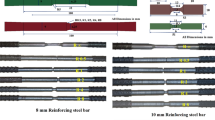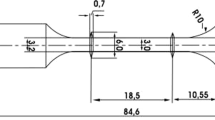Features of statically deformed steel 17G1S strain hardening after forty years of operation are studied. Physicomechanical interpretation is proposed for use of indentation data in order to evaluate steel 17G1S deformation properties at different scale levels. It is demonstrated by experiment that sensitivity of indentation methods depends on participation of different material structural levels in deformation, and also presence of scattered damage.



Similar content being viewed by others
References
H. Nykyforchyn, E. Lunarska, O. Tsyrulnyk, et al., “Effect of the long-term service of the gas pipeline on the properties of the ferrite-pearlite steel,” Mater. Corros., 60, 716–725 (2009).
E. Lunarska, Y. Ososkov, and Y. Jagodzinsky, “Correlation between critical hydrogen concentration and hydrogen damage of pipeline steel,” Int. J. Hydrogen Energy, 22, 279–284 (1997).
R. A. Siddiqui and H. A Abdullah, “Hydrogen embrittlement in 0.31% carbon steel used for petrochemical applications,” J. Mater. Proc. Technol., 170, 430–435 (2005).
P. Fassina, F. Bolzoni, G. Fumagalli, et al., “Influence of hydrogen and low temperature on mechanical behaviour of two pipeline steels,” Eng. Fract. Mechan., 81, 43–55 (2012).
Yu. V. Milman, H. M. Nykyforchyn, K. E. Hrinkevych, et al., “Assessment of the in-service degradation of pipeline steel by destructive and nondestructive methods,” Mat. Sci., 47, 583–589 (2012).
P. Yasniy, P. Maruschak, V. Hlado, and D. Baran, “Evaluation of hardening of plastically deformed steels,” Proc. 13th Int. Conf. Experimental Analysis of Nano and Engineering Materials and Structures, Alexandroupolis, Greece, July 1–6, 2007.
P. V. Yasnii, P. O. Marushchak, V. B. Hlado, and D. Ya. Baran, “Correlation of the microdislocation parameters with the hardness of plastically deformed heat-resistant steels,” Mat. Sci., 44, 194–200 (2008).
G. S. Pisarenko and A. A. Lebedev, Deformation and Strength of Materials with a Complex Stressed State [in Russian], Nauk. Dumka, Kiev (1976).
L. B. Zuev, V. I. Danilov, S. V. Konovalov, “Influence of contact potential difference and electric potential on the microhardness of metals,” Phys. Sol. State, 51, 1137–1141 (2009).
P. O. Maruschak, I. B. Okipnyi, L. Ya. Poberezhnyi, and E. V. Maruschak, “Study of heat-resistant steel strain hardening by indentation,” Metallurgist, 56, No. 11–12, 946–951 (2013).
M. A. Mohtadi-Bonab, J. A. Szpunar, and S. S. Razavi-Tousi, “A comparative study of hydrogen induced cracking behavior in API 5L X60 and X70 pipeline steels,” Eng. Fail. Analysis, 33, 163–175 (2013).
Author information
Authors and Affiliations
Corresponding author
Additional information
Translated from Khimicheskoe i Neftegazovoe Mashinostroenie, No. 1, pp. 40–42, January, 2014.
Rights and permissions
About this article
Cite this article
Marushchak, P.O., Salo, U.V., Bishchak, R.T. et al. Study of Main Gas Pipeline Steel Strain Hardening After Prolonged Operation. Chem Petrol Eng 50, 58–61 (2014). https://doi.org/10.1007/s10556-014-9855-4
Published:
Issue Date:
DOI: https://doi.org/10.1007/s10556-014-9855-4




